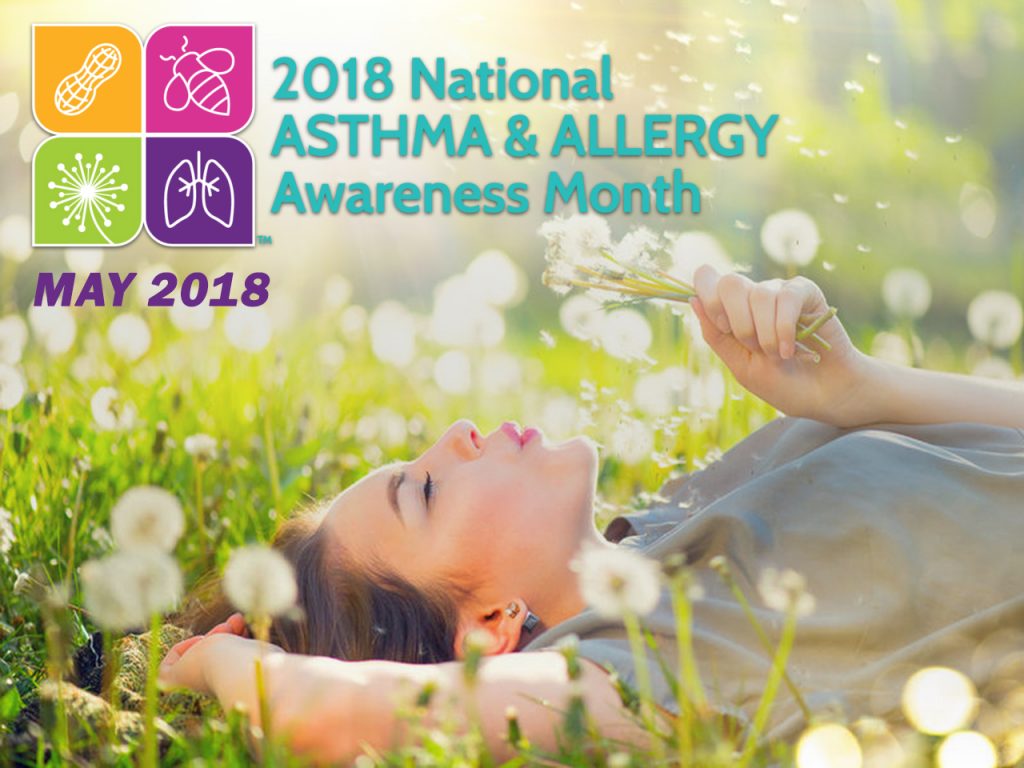Asthma and Allergies
 The Asthma and Allergy Foundation of America has declared May as National Asthma and Allergy Awareness Month. While the August-to-October ragweed season gets more attention, early-season and midsummer pollens can be every bit as devastating and sometimes more so for those who are sensitive to them. During the next 3 months beginning in May, tree pollens are already at an early-spring peak in the Southeast, where allergists say this is one of the worst seasons ever. The pollens have started to emerge in the Northeast, and over the next few weeks many residents in the New York area will face the sneezing, tears, runny nose, itchy eyes, headaches and general misery more often associated with ragweed in August.
The Asthma and Allergy Foundation of America has declared May as National Asthma and Allergy Awareness Month. While the August-to-October ragweed season gets more attention, early-season and midsummer pollens can be every bit as devastating and sometimes more so for those who are sensitive to them. During the next 3 months beginning in May, tree pollens are already at an early-spring peak in the Southeast, where allergists say this is one of the worst seasons ever. The pollens have started to emerge in the Northeast, and over the next few weeks many residents in the New York area will face the sneezing, tears, runny nose, itchy eyes, headaches and general misery more often associated with ragweed in August.
“A video posted to Facebook on Monday, in which a tree tapped by a frontloader releases a massive cloud of pollen, has gone viral, resonating with viewers in what experts say is an especially bad allergy season, partly because of climate change.” -EcoWatch [WATCH VIDEO]
Grass pollen will soon follow – followed by ragweed and other weeds. While there is no predictor in 2018, there have been some seasons where the three pollen seasons have overlapped. Not everyone is allergic to all three, but the cumulative effect for those who are sensitive can expect to be miserable over much of the year. For many with Spring allergies, March, April and May are the worst months. According to the American Academy of Allergy and Immunology, some individuals have a severe spring allergy with no fall allergy at all.
Much is known about pollen allergies – how to avoid and treat them – and national pollen-tracking centers have enabled millions to keep routine track of allergens in the air. Still, a wide variety of variables and unexpected weather conditions make predicting the course of a pollen season a tricky.
Rainfall (according to some experts) is the major influence in producing a heavy or light pollen season. On the basis of long-term forecasts, Schering Pharmaceuticals Corporation, predicts that the Midwest will experience a ”season of intense discomfort” this year. The company, which makes Chlor-Trimeton said it based its index on reports from 35 allergy experts throughout the country.
Is it a Cold or Allergies?
Many who are allergic are fooled by the effects of early pollens, said Sarah Kaluzny, a spokeswoman for the Academy: ”A lot think it’s a spring cold,” she said, ”but there is a difference between an allergy and colds.”
An allergic reaction to pollen is not usually accompanied by thick, yellowish nasal discharge, she said. Rather, the discharge is clear and it lasts much longer than a cold, which is over in a week or two. Common colds are caused by viruses, while seasonal allergies are immune system responses triggered by exposure to allergens, such as seasonal tree or grass pollens.
Managing Spring Allergies Symptoms
 When you are allergic to pollens or other environmental allergens, your immune system makes antibodies that identify a particular allergen as harmful, even though it isn’t. When you’re exposed to the allergen again, these antibodies can release a number of immune system chemicals, such as histamine, that cause allergy symptoms and your immune system’s reaction can inflame your skin, sinuses, airways or digestive system. You might be more likely to develop an allergy if you have asthma or have a family history of asthma.
When you are allergic to pollens or other environmental allergens, your immune system makes antibodies that identify a particular allergen as harmful, even though it isn’t. When you’re exposed to the allergen again, these antibodies can release a number of immune system chemicals, such as histamine, that cause allergy symptoms and your immune system’s reaction can inflame your skin, sinuses, airways or digestive system. You might be more likely to develop an allergy if you have asthma or have a family history of asthma.
Along with proper medication like antihistamines, decongestants, nasal sprays and desensitizing injections when appropriate, most physicians recommend these steps:
- Know the pollen count and stay indoors when it is high
- Close the windows at night
- Use air-conditioning, which cleans the air of pollen
- Avoid outdoor activities from 5 A.M. to 10 A.M., when pollen is released. The pollen count declines as the day goes on
- Keep the car windows closed when driving
- In the height of the pollen season, take a vacation to a place that is freer of pollen: a beach, for example, or a cruise aboard ship
- Do not mow the lawn during the grass pollen season, and stay away from freshly cut grass.
- Do not hang sheets or clothing out to dry. They collect pollen.
What is Allergic Asthma?
“About 25 million people in the US have asthma, and allergic asthma is the most common type, affecting around 60% of people with asthma. Both allergic and non-allergic asthma have the same symptoms, such as shortness of breath and wheezing.” – AAFA.org
Pollen during Spring allergy season are one of the common triggers for the onset of allergic asthma. Asthma inflames the airways and causes symptoms including coughing, wheezing, shortness of breath, rapid breathing and chest tightness. Those experiencing these symptoms, especially if the symptoms are prolonged and worsen, should seek medical attention. According to the AAFA, “10 people die from asthma everyday”, but although there is no cure for allergic asthma, many deaths are preventable with proper treatment and care.
Asthma and Obstructive Sleep Apnea: Identification, Understanding and Treatment
 RespiratoryEdu.org provides online approved online continuing education for Respiratory Therapists & Sleep Technologists. This month we are featuring the course: “Asthma and Obstructive Sleep Apnea: Identification, Understanding and Treatment” that is written by sleep medicine and respiratory care industry leaders; as well as being peer and/or physician reviewed.
RespiratoryEdu.org provides online approved online continuing education for Respiratory Therapists & Sleep Technologists. This month we are featuring the course: “Asthma and Obstructive Sleep Apnea: Identification, Understanding and Treatment” that is written by sleep medicine and respiratory care industry leaders; as well as being peer and/or physician reviewed.
This course is approved by the American Association for Respiratory Care (AARC) for CRCE credits; and by the Canadian Society Of Respiratory Therapists (CSRT) for CPD credits.
The course presentation will provide the learner with:
- An understanding of the pathology of asthma;
- An understanding of the clinical manifestations of concomitant asthma and OSAS;
- A review of the potential treatment options for the two coexistent diseases;
- Applicable resource materials that may be used to further education of the presence of asthma with OSAS.
To learn more, see our online store for each course accreditation type:








